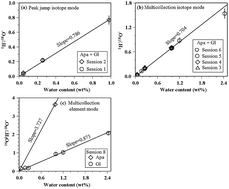Measurements of water content and D/H ratio in apatite and silicate glasses using a NanoSIMS 50L†
Abstract
Water plays an important role in evolution of the Earth, Mars, Moon and other planets, with H isotopes used as a crucial tracer for fractionation processes and water reservoirs. In order to accurately and precisely measure water contents and D/H ratios of apatite and silicate glass with high lateral resolution, we carried out a long term measurement with a NanoSIMS 50L, with special consideration for the H background, calibration of water content and instrumental mass fractionation. A detection limit of <10 ppm of water content has been achieved mainly by reducing the level of the H background, via improving vacuum and using a high primary beam current of up to 1 nA and a blanking technique. The measurements were carried out in three modes of detector configuration. In multicollection isotope mode, all 1H−, 2D−, 12C− and 18O− were measured simultaneously. Apatite and silicate glasses with water contents of <1.2 wt% were plotted on the same water content calibration curve with a slope of 0.704 ± 0.037 (2SD). In peak jump isotope mode, 1H−, 2D− and 12C− were first measured simultaneously at a magnetic field BF1, and then 18O− and other elements if needed at BF2 by switching the magnetic field. In this mode, apatite and MORB glass standards also share the same water content calibration curve with a slightly higher slope (0.786 ± 0.054, 2SD) relative to that of the multicollection isotope mode. In these two isotope modes, apatite and silicate glass standards have similar instrumental mass fractionation of H isotopes within the analytical uncertainty (45‰, 2SD) and similar precisions on water contents, however, the peak jump isotope mode can determine the volatile element contents and chlorine isotopes. In multicollection element mode, 16O1H− (for water content) and 18O− were measured simultaneously, accompanied usually by other volatile elements. The slope of the water content calibration curve of apatite (3.727 ± 0.112, 2SD) significantly differs from that of silicate glass (0.873 ± 0.049, 2SD). Multicollection element mode can only determine the water and volatile element contents with two times higher sensitivity than that of two isotope modes.

- This article is part of the themed collection: Analytical atomic spectrometry in China

 Please wait while we load your content...
Please wait while we load your content...